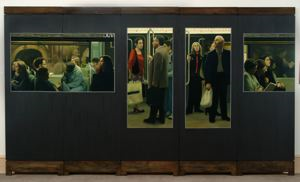
Dale Kennington (aka Dale Wilson Kennington)
American, 1935–2017
As though suspended from quotidian rhythms behind the sleek glass and metal wall of a contemporary train, city dwellers ride home. Observed through vertical rectangles, travelers stand randomly, grasping handrails, lost in personal musings. A man in front glances up as if verifying the list of stations. A woman on the left, her expression revealing weariness--the wages of shopping--holds her purchases in a colorful bag. Horizontal windows on either side disclose seated passengers also engaged in their individual activities: reading, staring into space. Discrete and disjoined one from the other, Kennington’s figures show the paradoxical isolation of the crowd, recognized by 19th century artists such as Honoré Daumier, who witnessed the effects of living in the first cities since antiquity approaching a million inhabitants. Coupled with this emotional isolation is the screen’s unpeopled obverse, an oblique view of triplicated escalators from the London tube. Projecting a Sisyphean futility, the lumbering mechanical stairs, devoid of passengers, rise and descend, their rounded ends looming into the viewer’s space. More an obstruction than an invitation to exit, the sign Way Out seems to bar visual escape. Even the colors are inhibitory: yellowish green and red, hues comparable to those of Vincent van Gogh’s Night Café.
American, 1935–2017
Long Day, Late Night
2002–2004
Object Type:
Painting
Dimensions:
93 in. x 160 in. (236.22 cm x 406.4 cm)
Medium and Support:
Oil on wood panel
Accession Number:
2004.0023
Credit Line:
Gift of Laura and Bradley Kennington
Copyright:
© Dale Kennington
As though suspended from quotidian rhythms behind the sleek glass and metal wall of a contemporary train, city dwellers ride home. Observed through vertical rectangles, travelers stand randomly, grasping handrails, lost in personal musings. A man in front glances up as if verifying the list of stations. A woman on the left, her expression revealing weariness--the wages of shopping--holds her purchases in a colorful bag. Horizontal windows on either side disclose seated passengers also engaged in their individual activities: reading, staring into space. Discrete and disjoined one from the other, Kennington’s figures show the paradoxical isolation of the crowd, recognized by 19th century artists such as Honoré Daumier, who witnessed the effects of living in the first cities since antiquity approaching a million inhabitants. Coupled with this emotional isolation is the screen’s unpeopled obverse, an oblique view of triplicated escalators from the London tube. Projecting a Sisyphean futility, the lumbering mechanical stairs, devoid of passengers, rise and descend, their rounded ends looming into the viewer’s space. More an obstruction than an invitation to exit, the sign Way Out seems to bar visual escape. Even the colors are inhibitory: yellowish green and red, hues comparable to those of Vincent van Gogh’s Night Café.
Keywords
Click a term to view the records with the same keyword
Additional Images
Click an image to view a larger version
Portfolio List
Click a portfolio name to view all the objects in that portfolio
This object is a member of the following portfolios:
Your current search criteria is: All Object records.

 by Artist (743)
by Artist (743)

